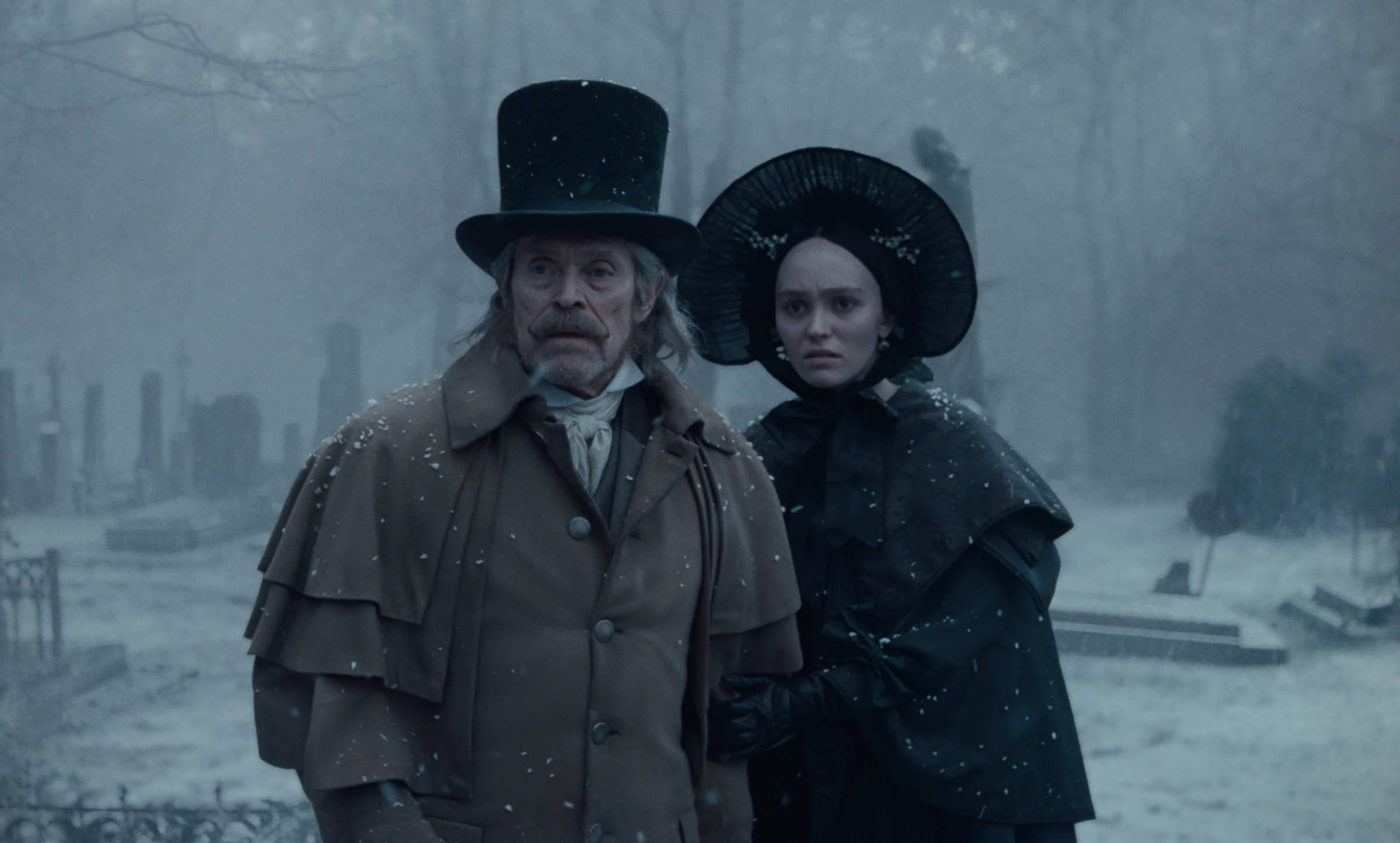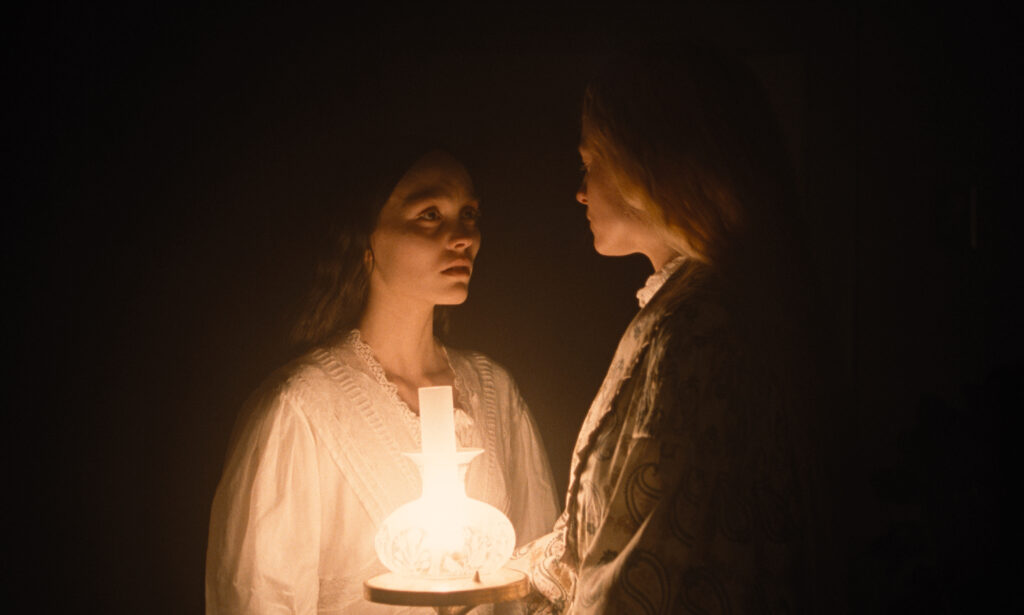Nosferatu Steps Into the 21st Century
Although his vampire flick falls short of earlier work, Robert Eggers has created a dreamworld unlike any other.

It has been more than 100 years since German filmmaker F.W. Murnau released the first great horror film, 1922’s silent Nosferatu. An unauthorized adaptation of the Irish author Bram Stoker’s 1897 novel Dracula, Murnau’s film singularly created the horror genre and inspired filmmakers for eras to come. So much so that the American filmmaker Robert Eggers, whose adaptation of Nosferatu was released on Christmas Day this year, cites Murnau’s work as an early inspiration after seeing the film at the impressionable age of nine.
Steeped in occultism, Murnau’s dimly lit, hermetic romp through Transylvania is as beguiling today as it was more than a century ago when all but a few copies were destroyed following a lawsuit filed by Stoker’s heirs. That the picture survived at all is every bit a mystery as the narrative woven by Murnau and writer Henrik Galeen who sought to transform vampire mythology through the moving image.
In the years since, other adaptations have attempted to broaden Count Orlock’s lore, such as Werner Herzog’s 1979 Nosferatu the Vampyre. Klaus Kinski’s sympathetic Orlock cut against Max Schreck’s grotesque and malevolent rendering in the original, and Herzog’s own atmospheric spin set his Nosferatu apart from Murnau’s. Eggers took no such detours remaking the classic. Though infused with a psychosexual cadence not nearly so overt in the original, Eggers remains dutifully bound to the original plotline of a newlywed woman plagued by the fever dreams of a vampire. The latest inception of Nosferatu is a haunting, ghostly, otherworldly affair that will leave its viewers struggling to discern dreams from reality as one character to the next suffers the wrath of Orlock’s plague.
A decade in the making, Eggers’ rendition sparkles in look and tone. The American cinematographer Jarin Blaschke, who collaborated with Eggers on The VVitch, The Lighthouse, and The Northman, produces his most stunning visual work to date. The lighting and color rivals the greatest to ever do it—the candle-lit scenes, in particular, contest even those of Stanley Kubrick’s brilliant 1975 historical drama Barry Lyndon, in which cinematographer John Alcott procured three superfast, proprietary lenses developed by Zeiss for use by NASA to capture the remarkable glow of pre-electric age interiors.

Blaschke’s tour de force is unmissable as his camera winds and twirls its way through a gypsy village in the Carpathian mountains south of Orlock’s mansion. In one long, unbroken shot, toothless vagrants chide and mock the estate agent Thomas Hutter, who has traveled from the cosmopolitan city of Wisborg to secure Orlock’s signature on the deed to a dilapidated mansion. These moments are where Eggers’s films shine brightest; the slow, hypnotizing camera allows the viewer to fully engage with the authentic embers of a pre-industrial town, full of bizarre rituals and unwelcome stares. His meticulous mise en scene and his rich attention to the genuine and subtle details that make a time and place is a talent rarely matched by any living filmmaker today.
Perhaps the most stunning sequence in the entire picture is a series of moonlit shots in which Hutter approaches the Count’s castle. Stark silvers and dreamy blues cascade upon a hematite-infused pathway as a horse-drawn carriage abruptly rumbles into the monochromatic frame. Here, Eggers’s appreciation for the 18th century German painter Caspar David Friedrich and the 16th century German painter Albrecht Dürer are unmistakable.
Eggers has spoken highly of both painters in recent interviews, telling the British Film Institute that as a child he almost burnt his comic books after being made aware of the gothic engravings by Dührer. When prodded about his influences during a conversation at Lincoln Center, Eggers first named Freidrich, whose iconic painting Wanderer Above the Sea of Fog could slot in seamlessly among the towering sea-side images that dot his Nosferatu.
A major departure from the original Nosferatu is in its ensemble cast who deftly situate the particular horror afflicted upon the whole city of Wisborg. Nicholas Hoult and Aaron Taylor-Johnson turn in top-notch performances as the two leading men who both struggle, in their own ways, with the specter of evil haunting their lands. Bill Skarsgård is unrecognizable as the beastly, violent Count Orlock. His voice acting is superb: The gravelly, asthmatic Orlock imbues the solemn air with terror each time he speaks. Cloaked in a jacket of hides, Orlock’s long, blackened fingers are all we see of him for half the film—and it is terrifying.
Lily-Rose Depp, daughter of Johnny Depp, gives the performance of her young career as the psychically-afflicted Ellen Hutter, the estate agent’s wife. Ellen is tormented by a childhood vision where she calls for a spirit to bring her love, only to be attacked by Orlock who will come for her again in the future. When her husband ventures to Transylvania to meet the count, Ellen is overcome by trances in sleep, drifting in and out of other realms. She levitates repeatedly and in one harrowing part of the film, she flings from sleep, her back arching forward in a scene that recalls Linda Blair’s turn in The Exorcist.
Willem Dafoe lives up to his billing as the mad-professor Albin Eberhart Von Franz, a controversial scientist learned in the occult who is summoned to attend to Ellen. Against the reasoned approach of his student, Dr. Wilhelm Sievers (Ralph Ineson), Dafoe’s character surmises that Ellen suffers from a deep, terrifying psychic connection with the count. It is in the play between these two men that the film finds its pace and perhaps most interesting material, the divide between scientific convention and occult mythmaking.
British-Irish film composer Robin Carolan produces a fantastic score that tugs at the melancholic threads that tie together the dreamworlds of its characters and the baroque, bleak reality set before them. The sound design is strong enough to carry the film itself. Hooves hiss, glasses clink, fires pop, and crooked doors creak from frame to frame, each lulling us deeper into the film’s mesmerizing gaze.
Eggers has stated in interviews that Nosferatu is the first complete film in his repertoire, the one that made him cringe the least during sessions in the editing bay. Much of that can be owed to the entrancing sound design, the captivating performances, the detailed costuming, and the gorgeous photography that marks each and every frame. That doesn’t mean Nosferatu is not without its faults. At times the pace feels sluggish, and, walking out after 2 hours and 15 minutes, I sensed that some of the fat could have been trimmed. I was not surprised to hear one moviegoer in the theater snoring during the climax of the film.
The writing, though an impressive feat of authentic period excellence in its own right, feels too theatrical at times, causing performances to drag. Perhaps a thinner script and a greater reliance on the otherworldly image and sound would have created a more engrossing end product.
Nevertheless, it’s a testament to Eggers’s oeuvre that what is, in my view, his weakest film to date is one which many of his contemporaries could only dream of creating once in a career. For nearly any other director, this film would be the crowning achievement of a life’s work. For Eggers, who is well on his way to earning a seat at the table of Kubrick, Altman, and Lynch, it’s a bit standard fare.
Nosferatu is likely to win big during award seasons. Though I doubt it will take home the top prizes for picture and direction, I expect this film to win high acclaim for its set design, its acting performances, its masterful sound, and incredible cinematography. And after? Eggers, only 41, already has a series of projects lined up in the coming years. He’s expressed interest in filming a western and has completed a medieval script titled The Knight. Onward and upward.
The post Nosferatu Steps Into the 21st Century appeared first on The American Conservative.

